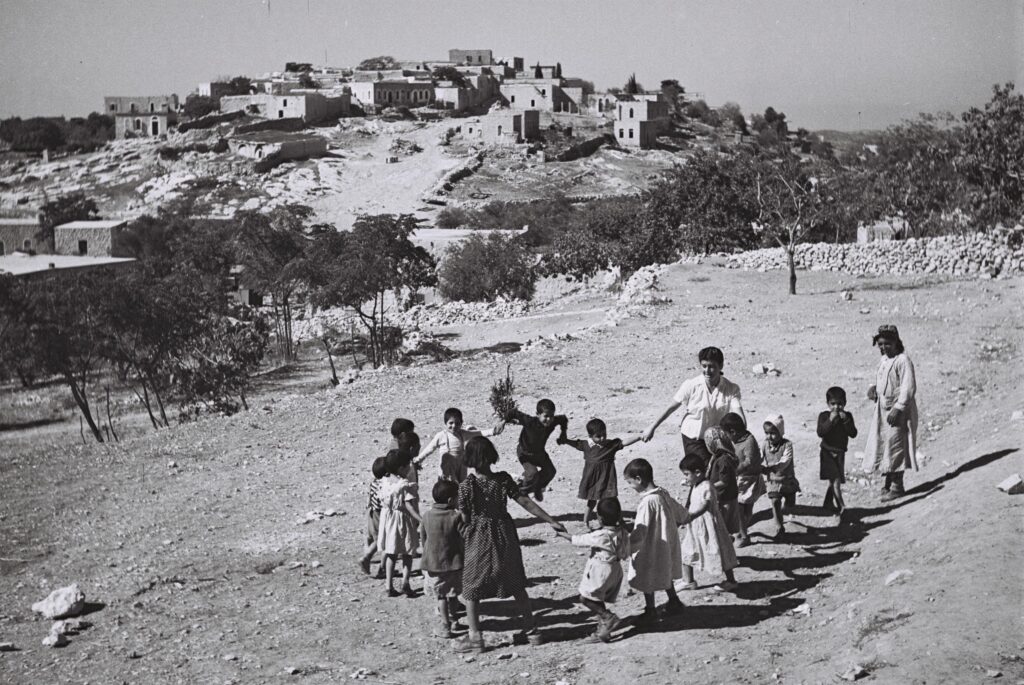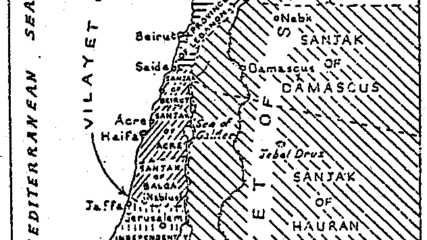CIE has compiled the following list of books and articles, including some available on our website, to guide understanding of Zionist and Israeli immigration.
Books
Alterman, Rachelle. Planning in the Face of Crisis: Land Use, Housing, and Mass Immigration in Israel. London: Routledge, 2002.
Alroey, Gur. An Uncompromising Land: Jewish Migration to Palestine in the Early Twentieth Century. Stanford, 2014.
Alroey, Gur. Land of Refuge: Immigration to Palestine, 1919-1927. Bloomington: Indiana University Press, 2024.
Avriel, Ehud. Open the Gates! A Personal Story of “Illegal” Immigration to Israel. London: Wiedenfeld and Nicolson, 1975.
Avruch, Kevin. American Immigrants in Israel: Social Identities and Change. Chicago: University of Chicago Press, 1981.
Bar-Yitshak, Hayah. Israeli Folk Narratives: Settlement, Immigration, Ethnicity. Detroit: Wayne State University Press, 2005.
Barer, Shlomo. The Magic Carpet. Harper and Brothers, 1952.
Bashkin, Orit. Impossible Exodus: Iraqi Jews in Israel. Stanford, CA: Stanford University Press, 2017.
Ben-Ezer, Gadi. The Ethiopian Jewish Exodus: Narratives of the Migration Journey to Israel 1977-1985. London: Routledge, 2002.
Benjamin, Marina. Last Days in Babylon: The Exile of Iraq’s Jews, the Story of My Family. Free Press, 2008.
Berger, Ludwig Lazarus, and Chaya Lazar. Israel and the Diaspora: An Indivisible Entity. Jerusalem: Office for Economic and Social Research, Jewish Agency, 1974.
Cohen-Goldner, Sarit, Zvi Eckstein and Yoram Weiss. Immigration and Labor Market Mobility in Israel, 1990 to 2009. Cambridge, MA: MIT Press, 2012.
Cohen, Richard I., and Judith Carp. The Return to the Land of Israel. Jerusalem: World Zionist Organization, Dor Hemschech, 1986.
Cohen, Yehoshua S. The Experience of Immigration: A Literary Perspective on Immigration to Israel. Jerusalem: Magnes Press, Hebrew University, 1998.
Deshen, Shlomo A. Immigrant Voters in Israel: Parties and Congregations in a Local Election Campaign. Manchester: Manchester University Press, 1970.
Deshen, Shlomo A., and Moshe Shokeid. The Predicament of Homecoming: Cultural and Social Life of North African Immigrants in Israel. Ithaca, NY: Cornell University Press, 1974.
Eisentadt, Shmuel N. The Absorption of Immigrants: A Comparative Study Based Mainly on the Jewish Community in Palestine and the State of Israel. London: Routledge and Kegan Paul, Ltd., 1954.
Elazar, Daniel. The Other Jews: The Sephardim Today. New York: Basic Books, 1989.
Ezzatyar, Ali. Iranian Immigration to Israel: History and Voices in the Shadow of Kings. London: Routledge, 2022.
Fialkova, L.L. Ex-Soviets in Israel: From Personal Narratives to a Group Portrait. Detroit: Wayne State University Press, 2007.
Golan, Bob, Jacob Howland and Bette Howland. A Long Way Home: The Story of a Jewish Youth, 1939-1949. Lanham, MD: University Press of America, 2005.
Goldner, Sarit Cohen. Immigration and Labor Market Mobility in Israel, 1990 to 2009. Cambridge, MA: MIT Press, 2009.
Goldscheider, Calvin. Israeli Society in the Twenty-First Century: Immigration, Inequality, and Religious Conflict. Waltham, MA: Brandeis University Press, 2015.
Goldscheider, Calvin. Israel’s Changing Society: Population, Ethnicity, and Development. Boulder, CO: Westview Press, 2002.
Govrin, Yosef. In the Shadow of Destruction: Recollections of Transnistria and Illegal Immigration to Eretz Israel, 1941-1947. London: Vallentine Mitchell, 2007.
Greenfield, Murray S., and Joseph M. Hochstein. The Jews’ Secret Fleet. Jerusalem: Gefen, 1996.
Hacohen, Mordechai. Homeland: From Clandestine Immigration to Israeli Independence. Beaufort Books, 2009.
Hadari, Ze’ev Venia, and Ze’ev Tsahor. Voyage to Freedom: An Episode of Illegal Immigration to Palestine. Valentine Mitchell, 1985.
Hakohen, Devorah. Immigrants in Turmoil: Mass Immigration to Israel and Its Repercussions in the 1950s and After. Syracuse, NY: Syracuse University Press, 2003.
Halamish, Aviva. “Jewish Immigration: The Base of the Palestine Triangle,” The British Mandate in Palestine, Michael Cohen (ed.). London: Routledge, 2020: 172-189.
Ioanid, Radu. The Ransom of the Jews: The Story of the Extraordinary Secret Bargain Between Romania and Israel. Chicago: Ivan R., 2005.
Israel State Archives, Immigration of Ethiopian Jews to Israel, 1948-1985, documents from the Ministry of Foreign Affairs, 2022.
Jones, Clive. Soviet Jewish Aliyah, 1989-1992: Impact and Implications for Israel and the Middle East. London: Frank Cass, 1996.
Kalir, Barak. Latino Migrants in the Jewish State: Undocumented Lives in Israel. Bloomington: Indiana University Press, 2010.
Klor, Sebastian, and Lenn J. Schramm. Between Exile and Exodus: Argentinian Jewish Immigration to Israel, 1948-1967; translated by Lenn Schramm. Detroit: Wayne State University Press, 2017.
Komaromi, Ann, ed. “Legalization and Mass Aliya,” “We Are Jews Again”: Jewish Activism in the Soviet Union, Yuli Kosharovsky et al., Syracuse, NY: Syracuse University Press, 2017: 249-322.
Krausz, Ernest. Studies of Israeli Society. New Brunswick, NJ: Transaction, 1980.
Krupnik, Adrián. Between Two Homelands: Argentine Migration to and From Israel. Tuscaloosa: University of Alabama Press, 2023.
Kossewska, Elżbieta. Polish Jews in Israel: Polish-Language Press, Culture, and Politics; translated by Scotia Gilroy. Leiden: Brill, 2021.
Lawrence, Norman. Israel: Jewish Population and Immigration. Washington: U.S. Government Printing Office, 1952.
Leibovitz, Liel. Aliya: Three Generations of American Jewish Immigration to Israel. St. Martin’s Griffin, 2007.
Leshem, Elazar, and Judith T. Shuval. Immigration to Israel: Sociological Perspectives. New Brunswick, NJ: Transaction Publishers, 1998.
Markus, Andrew, and Moshe Semyonov. Immigration and Nation Building: Australia and Israel Compared. Cheltenham: Edward Elgar, 2011.
Morgenstern, Arie, and Joel A. Linsider. Hastening Redemption: Messianism and the Resettlement of the Land of Israel. Oxford: Oxford University Press, 2006.
Morris, Yaakov. Pioneers From the West: A History of Colonization in Israel by Settlers From English-Speaking Countries. Westport, CT: Greenwood Press, 1972.
Neumann, Boaz. Land and Desire in Early Zionism. Waltham, MA: Brandeis University Press, 2011.
Ofer, Dalia. Escaping From the Holocaust: Illegal Immigration to the Land of Israel, 1939-1944. New York: Oxford University Press, 1990.
Paz, Alejandro I. Latinos in Israel: Citizenship and Language. Indiana University Press, 2018.
Pex, Judith Galblum. A People Tall and Smooth: Stories of Escape From Sudan to Israel. Cladach Publishing, 2011.
Rosenstein, Marc. “East Meets West: The Mass Aliyah From North Africa and the Mideast, 1949-64 CE,” Turning Points in Jewish History. Lincoln: University of Nebraska Press, 2018: 361-375.
Rebhun, Uzi, and Chaim Waxman. Jews in Israel: Contemporary Social and Cultural Patterns. Hanover: Brandeis University Press, 2004.
Sears, John F. Refuge Must Be Given: Eleanor Roosevelt, the Jewish Plight, and the Founding of Israel. West Lafayette, IN: Purdue University Press, 2021.
Schindler, Ruben, and David S. Ribner. The Trauma of Transition: The Psycho-Social Cost of Ethiopian Immigration to Israel. Aldershot, England: Avebury, 1997.
Schwarz, Tanya. Ethiopian Jewish Immigrants in Israel: The Homeland Postponed. Richmond, England: Curzon Press, 2001.
Shafir, Gershon, and Yoav Peled. Being Israeli: The Dynamics of Multiple Citizenship. New York: Cambridge University Press, 2002.
Shmuel, Naomi Anne. Children’s Wellbeing in Immigrant Families: Ethiopian Jews in Israel. Cham, Switzerland: Springer, 2023.
Shuelewitz, Malka Hillel. Forgotten Millions: The Modern Jewish Exodus From Arab Lands. Bloomsbery Academic, 2000.
Shuval, Judith T., and Elazer Leshem. Immigration to Israel: Sociological Perspectives. Transaction Books, 1998.
Sicron, Moshe. Immigration to Israel, 1948-1953. Jerusalem: Falk Project for Economic Research in Israel, 1957.
Siegel, Dina. The Great Immigration: Russian Jews in Israel. New York: Berghahn Books, 1998.
Stern, Eliahu. Chronology of the History of the New Yishuv in Eretz Yisrael, 1936-1947. Jerusalem: Yad Ben- Zvi, 1974.
Super, Arthur Saul, and David Lennon. Absorption of Immigrants. Jerusalem: Israel Digest, 1971.
Tsameret, Tsevi. The Melting Pot In Israel: The Commission of Inquiry Concerning Education in the Immigrant Camps During the Early Years of the State. State University of New York, 2002.
Wagaw, Teshome G. For Our Soul: Ethiopian Jews in Israel. Detroit: Wayne State University Press, 2018.
Warnes, Kathy. Wilbur Carr, the Imperial State Department and Immigration: 1920-1945, 2011.
Ziedenberg, Gerald. Blockade: The Story of Jewish Immigration to Palestine 1933-1948. Bloomington: Authorhouse, 2011.
Articles
Abramson, Scott, and Ken Stein, “Jewish Immigration to the Land of Israel (Zion) to 1949,” Center for Israel Education, March 2025.
Alroey, Gur, “Journey to Early Twentieth Century Palestine as a Jewish Immigrant Experience,” Jewish Social Studies, 9:2 (Winter 2003): 28-64.
Anderson, H. Dewey, “The Situation of Jews in Moslem Countries,” 1951, in The Arab Refugee Problem How It Can Be Solved, Chapter 14, “Proposals Submitted to the United Nations,” December 1951. This is an excellent summary of the demography and harrowing conditions that Jews sustained in specific Arab countries from 1946 to 1951.
Beenstock, Michael, “Failure to Absorb: Remigration by Immigrants into Israel,” International Migration Review, 30:4 (1996): 950-78.
Beenstock, Michael, and Jeffrey Fisher, “The Macroeconomic Effects of Immigration: Israel in the 1990s,” Weltwirtschaftliches Archiv, 133:2 (1997): 330-58.
Ben-Zadok, Efraim, “Oriental Jews in the Development Towns: Ethnicity, Economic Development, Budgets, and Politics,” in Efraim Ben-Zadok (ed.), Local Communities and the Israeli Polity: Conflict of Values and Interests. Albany: SUNY Press (1993): 91-122.
Bettin, Cristina, “The Role of the Holy Place in Memory and Nostalgia: The Immigration of Italian Jews to Israel Before and After WWII,” Forum Italicum, 45:2 (2011): 357-372.
Chiswick, Barry R., “Hebrew Language Usage: Determinants and Effects on Earnings Among Immigrants in Israel,” Journal of Population Economics, 11:2 (1998): 253-71.
Cohen, Uri, and Nissim Leon, “The New Mizrahi Middle Class: Ethnic Mobility and Class Integration in Israel,” Journal of Israeli History, 27 (2008): 1, 51-64.
Efrat, Elisha, “Geographical Distribution of the Soviet-Jewish New Immigrants in Israel,” GeoJournal, 24:4 (1991): 355-63.
Eisenstadt, S.N., “Change and Continuity in Israeli Society II. Dynamic Conservatism vs. Innovation,” The Jerusalem Quarterly, 2 (Winter 1977): 3-11.
Eisenstadt, S.N., “Israeli Society — Major Features and Problems,” The Jerusalem Quarterly, 1 (Fall 1976): 28-35.
Emmons, Shelese, “Russian Jewish Immigration and Its Effect on the State of Israel,” Indiana Journal of Global Legal Studies, 5:1 (1997): 341-55.
Flum, Hanoch, and Rachel Gali Cinamon, “Immigration and the Interplay Among Citizenship, Identity and Career: The Case of Ethiopian Immigration to Israel,” Journal of Vocational Behavior, 78:3 (2011): 372-380.
Friedberg, Rachel M., “The Impact of Mass Migration on the Israeli Labor Market,” Quarterly Journal of Economics, 116:4 (2001): 373-408.
Friedlander, Dov, and Calvin Goldscheider, “Immigration, Social Change and Cohort Fertility in Israel,” Population Studies, 32:2 (July 1978): 299-317.
Friedlander, Dov, “Mass Immigration and Population Dynamics in Israel,” Demography, 12:4 (November 1975): 581-99.
Gal, John, “Immigration and the Categorical Welfare State in Israel,” Social Service Review, 82:4 (2008): 639-61.
Gandal, Neil, Gordon H. Hanson and Matthew J. Slaughter, “Technology, Trade, and Adjustment to Immigration in Israel,” European Economic Review, 48:2 (2004): 403-428.
Gold, Steven, and Rona Hart, “Transnational Ties During a Time of Crisis: Israeli Emigration, 2000 to 2004,” International Migration (2009).
Gottheil, Fred M., “The Impact of Immigration on Size Distribution of Income in Israel,” The Journal of Developing Areas, 6:4 (July 1972): 523-34.
Gshur, Binyamin, and Barbara S. Okun, “Generational Effects on Marriage Patterns: Jewish Immigrants and Their Descendants in Israel,” Journal of Marriage and Family, 65:2 (2003): 287-301.
Halamish, Aviva, “Jewish Immigration: The Base of the Palestine Triangle,” in Michael Cohen (ed.), The British Mandate in Palestine: A Centenary Volume, 1920-2020: Routledge, 2020.
Halamish, Aviva, “Immigration Is Israel’s History, So Far,” Israel Studies, 23:3 (2018): 106-13.
Hartman, Moshe, and Harriet Hartman, “Long-Term Effects of International Migration: Lessons From Israel,” Population Research and Policy Review, 14:1 (1995): 45-69.
Kabha, Mustafa, “The Life of Jewish Immigrants From Muslim Countries in the Transit Camps as Reflected in the Arabic Journalistic Discourse in Israel, 1950-1967,” Israel Studies, 23.3 (2018): 123-31.
Kampinsky, Aaron, “Minister Zevulun Hammer’s Stance on the ‘Who Is a Jew?’ Issue,” Jewish Political Studies Review, 31, No. 1/2 (2020): 146-59.
Kaplan, Yehiel S., “Immigration Policy of Israel: The Unique Perspective of a Jewish State,” Touro Law Review, 31: 4 (2015): 1089-1135.
Khanin, Vladimir, “The Revival of ‘Russian’ Politics in Israel: The Case of the 2006 Election,” Israel Affairs, 13:2 (2007): 346-67.
Khazzoom, Aziza, “A Comparison of Talk About Arabs by Iraqi and Polish Women Who Immigrated to Israel in the 1950s,” Israel Studies, 23:2 (2018): 51-73.
Khazzoom, Aziza, “The Kibbutz in Immigration Narratives of Bourgeois Iraqi and Polish Jews Who Immigrated to Israel in the 1950s,” Israel Studies, 19:2 (Summer 2014): 70-93.
Klor, Sebastian, “‘Marginal Immigrants’: Jewish-Argentine Immigration to the State of Israel, 1948-1967,” Israel Studies, 21:2 (Summer 2016): 50-76.
Kochavi, Arieh J., “The Struggle Against Jewish Immigration to Palestine,” Middle Eastern Studies, 34:3 (July 1998): 146-67.
Kohn, Stephen J., “A Move to Israel,” The Wall Street Journal, New York Eastern Edition, May 20, 2013.
Lerner, Miri, and Yeoshua Hendeles, “New Entrepreneurs and Entrepreneurial Aspirations Among Immigrants From the Former U.S.S.R. in Israel,” Journal of Business Research, 36:1 (1996): 59-65.
Lewin-Epstein, Noah, and Yinon Cohen, “Ethnic Origin and Identity in the Jewish Population of Israel,” Journal of Ethnic and Migration Studies (June 2018): 1-20.
Meir-Glitzenstein, Esther, “Turning Points in the Historiography of Jewish Immigration From Arab Countries to Israel,” Israel Studies, 23:3 (2018): 114-22.
Milevsky, Avidan, “Challenges and Psychological Adjustment of Religious American Adolescent Immigrants to Israel,” Israel Studies, 21:2 (Summer 2016): 27-49.
Mittelberg, David, and Zvi Sobel, “Commitment, Ethnicity and Class as Factors in Emigration of Kibbutz and Non-Kibbutz Populations from Israel,” International Migration Review, 24:4 (1990): 768-82.
Peres, Yochanan, “Ethnic Relations in Israel,” American Journal of Sociology, 76:6 (1971): 1021.
Picard, Avi, “Building the Country or Rescuing the People: Ben-Gurion’s Attitude Towards Mass Jewish Immigration to Israel in the Mid-1950s,” Middle Eastern Studies, 54:3 (May 2018): 382-399.
Powell, Benjamin, J.R. Clark and Alex Nowrasteh, “Does Mass Immigration Destroy Institutions? 1990s Israel as a Natural Experiment,” Journal of Economic Behavior and Organization, 141 (2017): 83-95.
Preuss, W., “The Economic Effects of Jewish Immigration in Palestine,” in Harry Vitteles and Khalil Totah (eds.), The Annals of the American Academy of Political and Social Science, 164, Philadelphia (November 1932): 108-15.
Raijman, Rebeca, and Rona Geffen, “Sense of Belonging and Life Satisfaction Among Post‐1990 Immigrants in Israel,” International Migration, 56:3 (June 2018): 142-157.
Rebhun, Uzi, “Immigration, Gender, and Earnings in Israel,” European Journal of Population, 26:1 (2010): 73-97.
Sapir, Gideon, and Mark Goldfeder, “Law, Religion, and Immigration: Building Bridges With Express Lanes,” Emory International Law Review, 32:2 (February 2018): 201-254.
Shamai, Shmuel, and Zinaida Ilatov, “Assimilation and Ethnic Boundaries: Israeli Students’ Attitudes Toward Soviet Immigrants,” Adolescence, 36:144 (2001): 681-695.
Sharaby, Rachel, “Immigration and Entry Into the Cultural Mainstream,” International Migration, 53:4 (August 2015): 155-175.
Shiffman, S., “The Pain of Two Homelands: Immigration to Israel in Twenty-First Century Hebrew Prose Fiction,” Hebrew Studies, 56 (2015): 315-331.
Shohat, Ella, “Sephardim in Israel: Zionism From the Standpoint of Its Jewish Victims,” Social Text, 19/20 (1988): 1-35.
Shumsky, Abraham, “Motivation to Change: A Study of Western Immigration to Israel,” Journal of Educational Sociology, 36:4 (December 1962): 190-192.
Sigad, Laura, et al., “The Meaning of Work Among Immigrants Living in Poverty in Israel: Replanting Roots of Belonging,” International Journal of Social Welfare, 27:2 (April 2018): 197-206.
Spilerman, Seymour, and Jack Habib, “Development Towns in Israel: The Role of Community in Creating Ethnic Disparities in Labor Force Characteristics,” American Journal of Sociology, 81:4 (1976): 781.
Talmi Cohn, Ravit, “Time Making and Place Making: A Journey of Immigration From Ethiopia to Israel,” Ethnos: Journal of Anthropology, 83:2 (April 2018): 335-352.
Tobin, Andrew, “Why Tel Aviv Is Israel’s New Aliyah Capital,” The Times of Israel, January 1, 2016.
Toktas, Sule, “Turkey’s Jews and Their Immigration to Israel,” Middle Eastern Studies, 42:3 (2006): 505-519.
Walsh, Sophie, and Shmuel Shulman, “Gender-Related Needs, Challenges, and Dangers in the Immigration Experience in Israel of Emerging Adults From the Former Soviet Union,” Sex Roles, 54:7 (2006): 533-546.
Weingrod, Alex, “The Two Israels Revisited,” Israel Studies, 23:3 (2018): 132-40.
Weiss, Amy, “1948’s Forgotten Soldiers? The Shifting Reception of American Volunteers in Israel’s War of Independence,” Israel Studies, 25, No. 1 (2020): 149-73.
Yaron, Hadas, “Infiltrators or Refugees? An Analysis of Israel’s Policy Towards African Asylum-Seekers,” International Migration, 51:4 (2013): 144-57.









